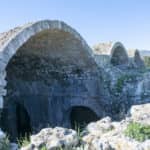 The Greek island of Crete is filled with many beautiful sites to behold. In addition to being physically beautiful, it has a long and rich history that actually spans thousands of years. Home to the Ancient Minoans, this island is one of the first to have evidence of being inhabited in Greece. Because of that, there are some excellent historical landmarks and archaeological sites to see while here. Ancient Aptera is one of them. Here’s more information:
The Greek island of Crete is filled with many beautiful sites to behold. In addition to being physically beautiful, it has a long and rich history that actually spans thousands of years. Home to the Ancient Minoans, this island is one of the first to have evidence of being inhabited in Greece. Because of that, there are some excellent historical landmarks and archaeological sites to see while here. Ancient Aptera is one of them. Here’s more information:
About Ancient Aptera
Ancient Aptera is located on the top of a flat hilltop, overlooking the Souda Bay with a magnificent view of the sea. The entire area is surrounded by the remains of stone fortification walls. It is advisable to drive to Aptera either by bus or by other means of transportation.
Once there, you will have to pay a small entry fee to explore the archaeological site and you’ll be able to explore the grounds on foot, so be sure to wear good shoes. The best hours to arrive are early in the morning to avoid the tourist crowds, but if you can’t, the crowds are usually gone by mid-afternoon. If you are to arrive after or before opening hours, the only section open to the public will be the ruins of a Roman house.
There is evidence here of the Ancient Greeks, Ancient Romans, and even the Ottoman Empire. After it was founded in seventh century BC, it was one of the most important city-states of Crete. It held such a significant economic influence of ancient Greece and Rome that coins were minted with the inscription “Aptera” next to the depiction of the goddess Hera. But after an earthquake occurred in the seventh century AD, the land was temporarily abandoned. It was revived by the Byzantines three centuries later.
Ancient Sites to See at Aptera
Greek Theater and Temples
It is a top tourist spot because of the Greek theater found on its site. Once it was excavated and opened, there was a rhapsody from Homer’s “The Odyssey” that was performed for the public by actors Sofia Hill and Antonis Myriagos. At the height of its popularity, the theater had the estimated capacity of almost 4,000 spectators. This is the best place to find shade underneath the beautiful olive trees that surround the theater. There are also excavated parts of several Doric temples around the theater.
Roman Cisterns and Bath Houses
The classic Roman brickwork and archways are a testament to the impressive engineering feats of Ancient Rome and can be found throughout Aptera. The three-vaulted cistern which once held water is of a massive size that can’t be missed. There is also a roman villa located on the site but not much is left of it expect for the giant pillars. One can only imagine the splendor that the villa must have had in its time.
Turkish Fortress
In 1872, the Turks built a fortress to overlook the Souda Bay during the Cretan Revolution of 1866. It was constructed to control the valley of Vamos as well as the gulf during the revolution. It still represents as a fine example of of military architecture of the 19th century.
Monastery of Saint John the Theologian
It was established in the 12th century, it’s the center of the grounds and is located next to the Roman cisterns. The monastery was eventually abandoned in 1964 but the building still stands today and includes a chapel and a two-story block of monks’ cells.
While on the Greek island of Crete, you will want to visit Ancient Aptera!

